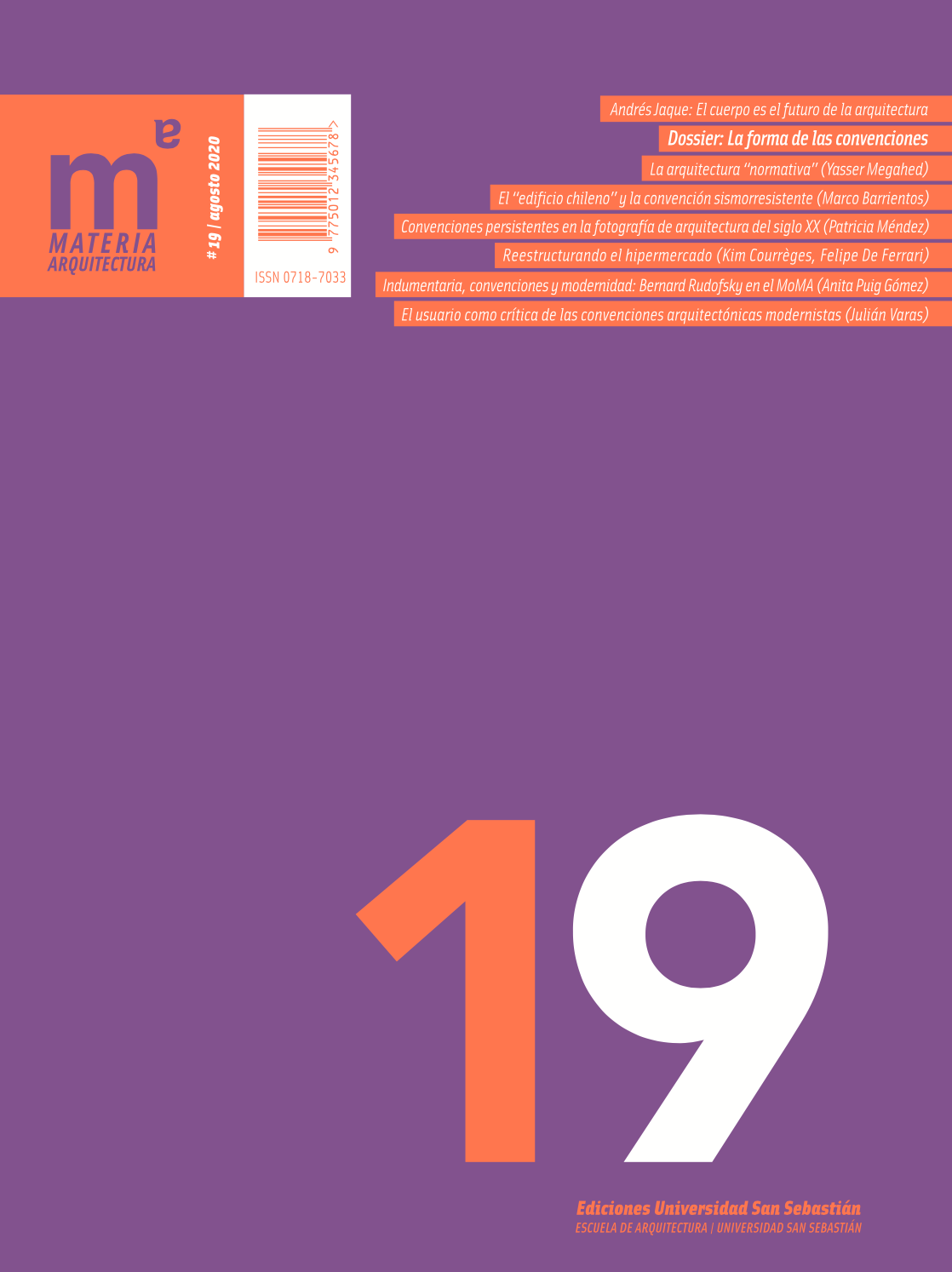On ‘Normative’ Architecture. Notes on the Domination of the Technical-rational Mode of Thinking on Mainstream Architectural Production: A Historical Highlight
Barra lateral del artículo
Palabras clave:
Contenido principal del artículo
Resumen
The term ‘mainstream’ or ‘normative’ practice is often used to describe the model of architectural practice that
is often generic in its architectural ambition and tends to appeal to the economic rules of the market. This model of practice follows what can be called a 'technical-rational ideology' that prioritizes discourses of efficiency, audit, and profitable and timely delivery. This paper will highlight some moments in the history of architectural production that paved the way for the domination of the technical-rational ideology on contemporary architectural production, coming across ideas from Jean-Nicolas-Louis Durand and Leslie Martin, and Design Methods that were influential in shaping mainstream architectural practice. The paper concludes with speculations on the future trajectory of the architectural profession in the light of the current prevalence of this ideology.
Detalles del artículo
Materia Arquitectura proporciona acceso inmediato y gratuito a todos los contenidos de esta edición electrónica, publicada simultáneamente con la edición impresa. Materia Arquitectura no cobra honorarios a los autores por ningún concepto.
Todos los contenidos de esta edición electrónica se distribuyen bajo licencia Creative Commons de “Atribución-Copartirigual 4.0 Internacional” (CC-BY-SA).
La licencia Creative Commons permite el acceso libre e inmediato al contenido y permite que cualquier usuario lea, descargue, copie, distribuya, imprima, busque o genere enlaces a los textos completos de los artículos, permitiendo también que estos puedan ser rastreados para indexarlos, pasarlos como datos a software o usarlos para cualquier otro propósito legal. Asimismo, la licencia otorga derechos de uso a quienes a su vez utilicen una licencia abierta (Creative Commons o equivalente).
Los derechos de los textos y las imágenes publicadas pertenecen a sus autores, quienes otorgan a Materia Arquitectura la licencia para su uso. La gestión de los permisos y la autorización de publicación de las imágenes (o de cualquier material) que contenga derechos de autor y sus consecuentes derechos de reproducción en esta publicación es de exclusiva responsabilidad de los autores de los artículos.
Toda vez que mencionen su origen, los autores son libres de distribuir sus artículos por otros medios. Cualquier reproducción total o parcial del material deberá citar su procedencia.
Descargas
Citas
Methods in Architecture (No. 6). Lund Humphries.
BROSHAR, M., STRONG, N., & FRIEDMAN, D. S. (2010). Report on Integrated Practice [Report]. American Institute of Architects.
COLE-COLANDER, C. (2003). Designing the Customer Experience. Building Research & Information, 31(5), 357– 366. https://doi.org/10.1080/0961321032000088025
CRINSON, M., & LUBBOCK, J. (1994). Architecture: Art or Profession? Three Hundred Years of Architectural Education in Britain. Manchester University Press.
CUFF, D. (1992). Architecture: The Story of Practice. MIT Press.
DURAND, J. N. L. (1813). Nouveau précis des leçons d’architecture données à l’École imperiale polytechnique. Retrieved from http://archive.org/details/ gri_000133125012233678
FRAMPTON, K. (2007). Modern Architecture: A Critical History. Thames & Hudson.
GUTMAN, R. (1988). Architectural Practice: A Critical View. Princeton Architectural Press.
HILL, S., BRINKLEY, I., JOHAR, I., & FOXELL, S. (2010).
Risk, Entrepreneurialism, Practice and the Professional Institute [Building Futures Report]. RIBA.
HACKING, I. (1983). Representing and Intervening: Introductory Topics in the Philosophy of Natural Science. Cambridge University Press.
HUGHES, F. (2014). The Architecture of Error: Matter, Measure, and the Misadventures of Precision. MIT Press.
JENCKS, C. (1987). Le Corbusier and the Tragic View of Architecture. Penguin.
KIERAN, S., & TIMBERLAKE, J. (2003). Refabricating Architecture: How Manufacturing Methodologies are Poised to Transform Building Construction. McGraw-Hill Education.
KOOLHAAS, R., & FOSTER, H. (2013). Junkspace with Running Room. Notting Hill.
LAWSON, B. (2014). How Designers Think: The Design Process Demystified. Routledge.
MARTIN, J. L. (1983). Buildings and Ideas: 1933–1983. Cambridge University Press.
MCELROY, M. (1984). Marketing: How Big Corporations Choose Design Firms. Architectural Record, 172(7), 45 -47.
Yasser Megahed
MCVICAR, M. (2012). God is in the Details’ / ‘The Detail is Moot’: A Meeting Between Mies and Koolhaas. In A. Sharr (Ed.), Reading Architecture and Culture: Researching Buildings, Spaces and Documents (pp. 165-178). Routledge.
MEGAHED, Y., & SHARR, A. (2018). Practiceopolis: From an Imaginary City to a Graphic Novel. Journal of Architectural Education, 72(1), 146–166. https://doi.org/10. 1080/10464883.2018.1410670
MURPHY, D. (2016). Last Futures: Nature, Technology and the End of Architecture. Verso.
OMA, KOOLHAAS, R., & MAU, B. (2003). S, M, L, XL (J. Sigler, Ed.). The Monacelli Press.
PÉREZ GÓMEZ, A. (1983). Architecture and the Crises of Modern Science. MIT Press.
PRASAD, S. (2004). Inclusive Maps. In S. Macmillan (Ed.),
Designing Better Building: Quality and Value in the Built Environment (pp. 175–184). Taylor & Francis.
ROBINSON, D., JAMIESON, C., WORTHINGTON, J., & COLE, C. (2010). The Future for Architects? [Building Futures Report]. RIBA.
SCHÖN, D. A. (1987). Educating the Reflective Practitioner: Toward a New Design for Teaching and Learning in the Professions. Jossey-Bass.
SCHÖN, D. A. (2017). The Reflective Practitioner: How Professionals Think in Action. Routledge.
SHARR, A. (2010). Leslie Martin and the Science of Architectural Form. In A. Dutoit, J. Odgers, & A. Sharr (Eds.), Quality out of Control: Standards for Measuring Architecture (pp. 67-78). Routledge.
VESELY, D. (2004). Architecture in the Age of Divided Representation: The Question of Creativity in the Shadow of Production. MIT Press.
VILLARI, S. (1990). J.N.L. Durand (1760-1834): Art and Science of Architecture. Rizzoli.
WOUDHUYSEN, J., & ABLEY, I. (2004). Why is Construction so Backward? Wiley-Academy.
Artículos más leídos del mismo autor/a
- Yasser Megahed, ACERCA DE LA ARQUITECTURA “NORMATIVA”. NOTAS ACERCA DEL DOMINIO DEL MODO TÉCNICO-RACIONAL DE PENSAMIENTO EN LA PRODUCCIÓN ARQUITECTÓNICA CONVENCIONAL: UNA REVISIÓN HISTÓRICA , Materia Arquitectura: Núm. 19 (2020): Materia Arquitectura 19 (Agosto/August 2020)
